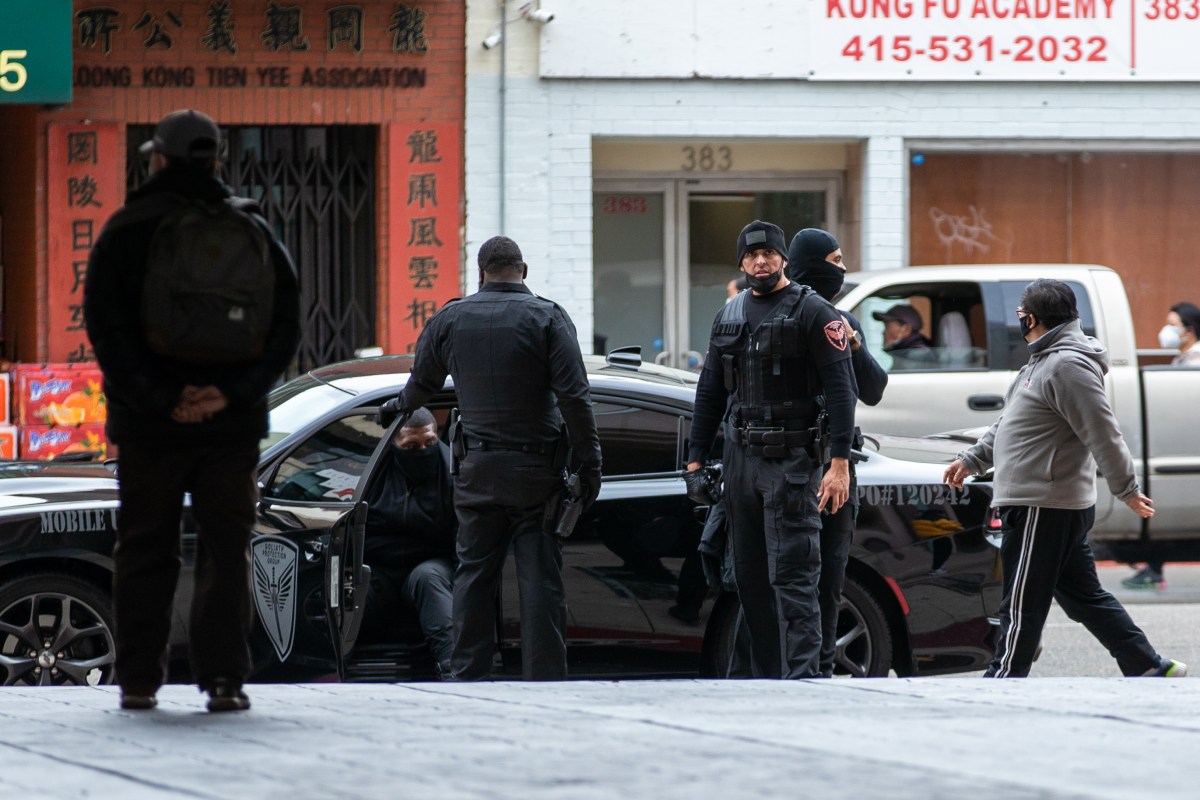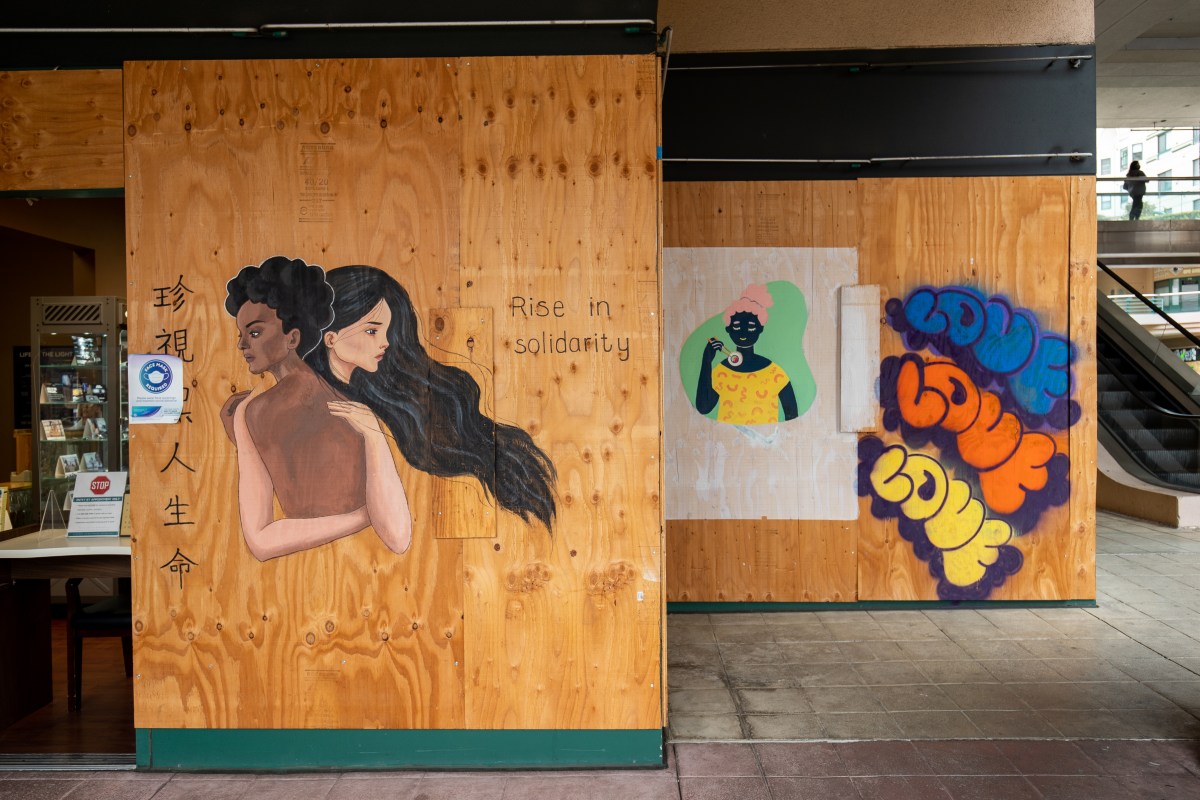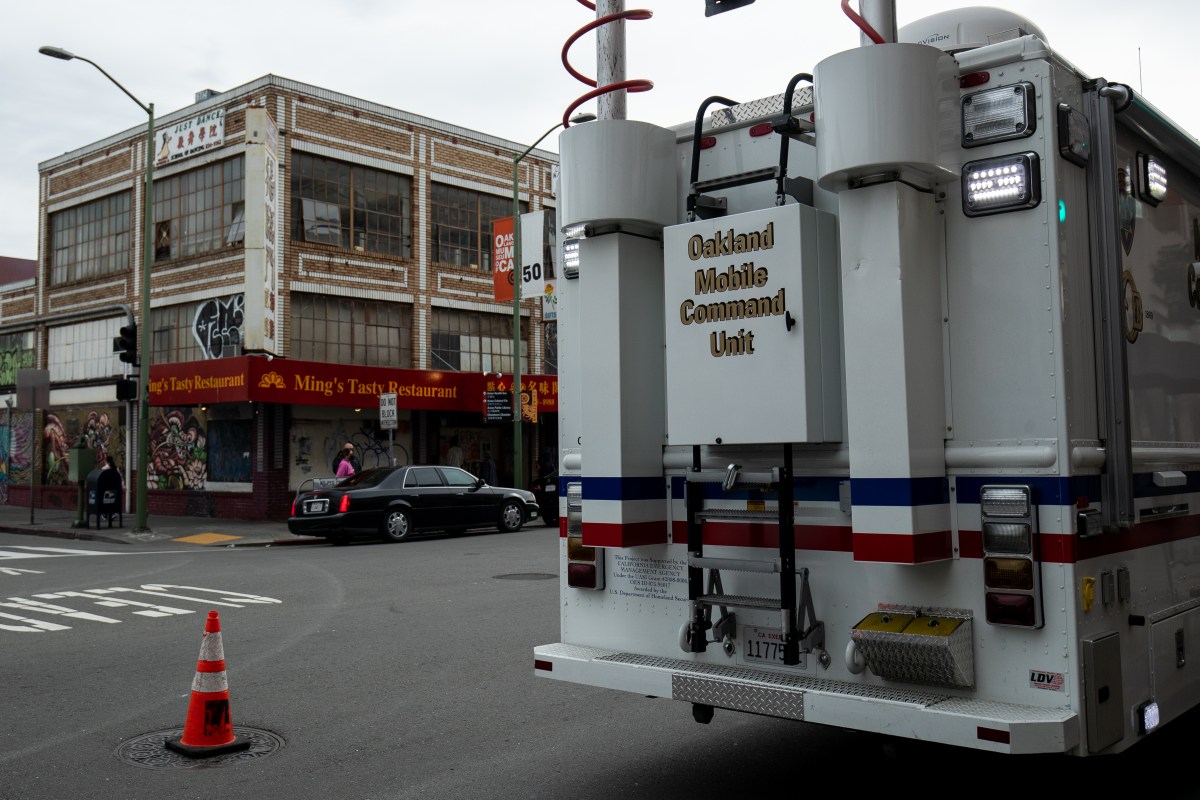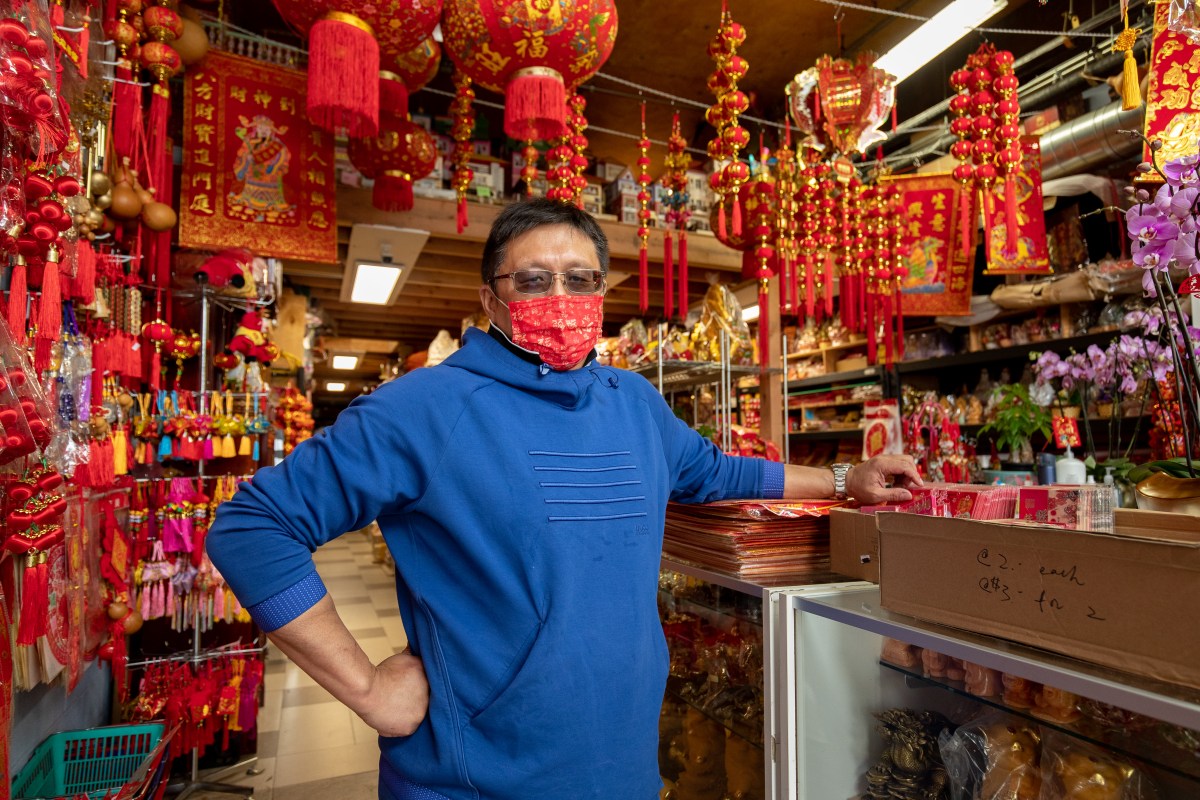On Sunday morning, Jan. 31, Kenneth Lam and his wife were working at the popular florist shop they’ve owned for 10 years on Webster Street in Oakland Chinatown when three women ran into the store, attempting to take potted trees and other items without paying for them. The Lams physically struggled with the women, were injured in the process, and nearly hit by a car as it sped away.
“We still continued working the day that it happened,” said Kenneth Lam, who is in his 50s. “My back is hurting like hell, but unfortunately we don’t get breaks.”
About this report
This is part two of a series; read part one.
This article has been translated to Chinese. Read the traditional version (繁體中文版) or simplified version (简体中文版).
This report was produced in collaboration with Oakland Voices, a program led by the Maynard Institute for Journalism Education to train Oakland residents to tell the stories of their neighborhoods.
About 20 minutes later, officers from the Oakland Police Department arrived to take down a report. “Normally, it takes them a couple of hours,” said Lam. After the robbery, his parents urged him to close the store, but he didn’t feel that he could. Not only are Lam’s children taking time off from school to help with the business, but Lam had quit his full-time job and put aside three other sources of income to help support his wife’s passion of working as a florist. “I love my wife, and this is what she likes to do,” he said.
Several Chinatown merchants also say robberies are happening much more regularly. Tiffany Fang, another longtime Chinatown florist, said she used to hear about robberies in Chinatown “once every blue moon.” Now, it feels like at least every other week. And last month’s robbery at the Lams’ shop felt all too familiar to the shopkeepers. “During the last six months or so, we’ve been robbed three times already in the shop,” said Lam.
Many people expected the pandemic to lead to a spike in property crimes like burglaries and shoplifting, and violent crimes like armed robbery, due to desperation caused by the economic shutdown and resulting job losses. But in Oakland, and across the country, these types of crimes have actually dropped over the past year. A few categories of property crime have gone up, like auto burglaries, but not enough to reverse the overall trend of declining property crime.
Is Chinatown an outlier?
A week ago, The Oaklandside asked the Oakland Police Department for a full year of crime data for the Chinatown neighborhood. So far, OPD has not fulfilled this request, which we’ve followed up on multiple times.
The only official reports we can draw from are the OPD’s weekly rundowns of crime, which cover the entire city and also break it down into five large areas. Chinatown is part of Area 1, which also includes the rest of downtown, the Jack London District, and all of West Oakland. According to OPD’s most recent weekly report for Area 1, reported crime is down by 55% so far this year compared to the same period of time last year. Reports of assault, rape, and robbery have all dropped.
This is true across all of Oakland. The only type of violent crime that has significantly increased since the pandemic began is gun violence. Firearms assaults increased by 71% in 2020 and murders were up by 38%.
But Area 1 covers a lot of ground. We still wanted to drill down into data confined to Chinatown to see if there has been a recent major spike in violent crimes reported there, so we pulled raw crime data for the entire city from the past 90 days—everything that was available—from the city’s data portal.
Between Nov. 11, 2020 and Feb. 9, 2021 there were 262 crimes reported in the “Beat 3x” section of OPD’s Patrol Area 1. Beat 3x almost perfectly overlaps with Chinatown: it’s bounded by Broadway, 14th Street, the Lake Merritt channel, and the I-880 freeway. Although we can’t compare the 90 days of data to the same 90-day span of time last year through the portal, because it doesn’t go back that far, we can see if there was an increase in violent crime within the 90-day timeframe.
The data does show a recent increase in reported crime in Chinatown. During the first 45 days (from Nov. 11 to Dec. 25) there were 116 crimes reported in beat 3x, and in the final 45 days of the dataset, there were 146 crimes reported—more than a 25% increase. Using the same analysis, we found that violent crime incidents increased from 27 to 35, a nearly 30% increase.
We widened our analysis to other parts of the city and found that Chinatown is not among Oakland neighborhoods with the highest rates of crime. There are 35 numbered police beats across Oakland, small geographic areas that roughly match up with specific neighborhoods. Many are split in two and designated with an “x” or “y,” resulting in 59 actual beats for which data is collected. Over the past 90 days, Chinatown ranked 18th out of 59 in the city in terms of the number of crimes reported.
The police beats with the highest numbers of crimes in the past 90 days overlap with the San Antonio neighborhood east of Lake Merritt (where Asians make up the largest racial group at 42% of the population), Uptown and downtown (where the population is mostly Black and white), and Eastmont and Arroyo Viejo in deep East Oakland (where Black people and Latinos are the majority). The neighborhoods with the least reported crime are contained within police beats that overlap with Skyline Boulevard, Upper Rockridge, and Trestle Glen, all predominantly white and affluent areas.
But while Chinatown doesn’t appear to be experiencing more crime than other non-white neighborhoods, it does appear that crime notably rose there in recent months. Looking at the last 90 days of crime reports across Oakland, citywide crime dropped by 3% over the past 45 days, while Chinatown saw at least a 25% increase in the same time.
Why the recent rise? It’s too early to say for sure, but Chinatown merchants have some theories. For one thing, it’s well-known in Asian-American communities that crimes of opportunity increase each year with the approach of Lunar New Year, a holiday that can span several weeks, is celebrated by many Asian diasporic communities, and begins on February 12 this year.

“People know that Asian communities are going out for the New Year’s or just buying stuff,” said Fang. “There’s a lot more people, especially old folks, needing to get stuff done.”
Other merchants say there’s a sense that the prevalence of elders out and about in Chinatown lends to the perception—and, in some cases, the reality—that the neighborhood is an easier target.
Fang’s advice to Chinatown residents and families? “If you have grandparents that shop here, come with them,” she said. “When there’s more than just one person, there’s probably less likelihood” that they’ll be harmed.
And after one of their staff members was robbed after leaving work several weeks ago, Asian Health Services, a community health center at 8th and Oak, started providing escorts to accompany employees to their cars in the mornings and evenings.
“We recognize there are many roots of violence—poverty, mental health, homelessness,” said Julia Liou, an administrator at Asian Health Services. “There’s a lot of socioeconomic factors that impact mental health.”
Kenneth Lam, whose shop experienced an attempted robbery last month, said Chinatown merchants have pooled roughly $50,000 to purchase personal protection devices, including whistles and mace, for businesses to distribute to employees. Lam also wants self-defense classes to be provided for Chinatown residents, including the elderly.
“Our message to people who think that they can come into Chinatown and just do this is, think twice,” said Lam. “We will fight back.”
After violent attacks leave many feeling unsafe, what can community-driven solutions look like?
Some we spoke to in and about Chinatown had mixed feelings about calling for increased police presence and private security—and say they’ve been glad to see civilian-led volunteer efforts popping up as potential alternatives.
“When [police] have more foot patrol, there were less of these crimes,” said Fang, the florist. But she’s happy to see other kinds of responses to crime spring up in the wake of the recent robberies and assaults, and she hopes that continues. “What’s great is there’s a bunch of citizens now that form a security patrol, that walks around in blue vests,” she said. “It’s just people who strongly believe to keep an eye out.”
In the past couple weeks, at least five such civilian-led volunteer efforts have sprung up. One is called Compassion in Oakland, started by Jacob Azevedo, a young Latino Oaklander who works in Chinatown. On Thursday, Feb. 11, Compassion in Oakland held their first meeting for potential volunteers. The group plans to launch its chaperone services this Saturday morning. The group aims to provide the Chinatown community a visible resource for safety, and embrace “the often forgotten, underserved, and vulnerable.” They plan to keep a close watch at ATMs, bus stops, parking lots, the Lake Merritt BART station, and Asian Health Services. The group, led by five leaders, including Azevedo, stressed that they are not vigilantes. Since the group launched, more than 300 people have expressed interest in volunteering.
The group is endorsed by the Oakland Chinatown Chamber of Commerce, and has the support of local law enforcement. Members are encouraged to call 911 and OPD emergency dispatch if there is a conflict, so that first responders can also tend to any potential injuries. During the meeting for potential volunteers, some raised concerns over how OPD should be involved and asked if the effort’s leaders knew about Community Ready Corps, a Black-led community safety group that has watched over recent protests, and was recently awarded a contract to provide security to all Peralta College campuses.
Leadership expressed interest in following up about CRC and explained why they’re working with OPD. “I myself am incredibly frustrated with police departments across the country,” said Azevedo. “I want police departments to be held accountable for any actions that aren’t in line with the law. But they’re still law enforcement, and the only way their image is going to get better is working with community programs like us.”
While the group doesn’t have the capacity to teach self-defense, they’re hoping to attract more people with experience in de-escalation.

Over the past weekend, city councilmembers Nikki Fortunato Bas and Carroll Fife, members of the Oakland Chinatown Coalition, and others, like Tur-ha Ak, co-founder of Community Ready Corps, joined strolls around Chinatown.
Led by Fife, among others, the discussion around community safety continued online in multiple live-streams, with other councilmembers, including Bas and Councilmember Rebecca Kaplan, as well as with her chief of staff, Tonya Love. Fife outlined her views about what really drives crime, specifically robberies and burglaries: “Until we address the primary predator—the white supremacy that creates criminality—we will always have secondary predators because their primary needs haven’t been met,” said Fife during the livestream with Love. “Just because those conditions exist, doesn’t mean we won’t deal with the secondary predators, but we have to understand that the conditions that create those predators should be our number one issue.”
Fife elaborated on the Defund the Police movement, which has risen again last year following the deaths of George Floyd and Breonna Taylor, saying that defunding is a concept, and doesn’t necessarily mean immediately “taking the police and putting them in the trash,” even as OPD overspent on their budget by $32 million—a large portion of that towards overtime—in the last fiscal year. “But to say the defund movement is causing crimes and attacks against our Asian neighbors is sickening.”
John Jones III, a third-generation East Oakland resident and director of community and political engagement for Just Cities, emphasized the importance of acknowledging both the violence being inflicted on elderly Asian people, whether through robberies or assaults, as well as the wider consequences of policies and plans formed to address such crimes.
“As a descendent of a people and race who have been subjected to some of the most cruel and inhumane behaviors and policies, those experiences have taught me the importance of using that experience as a bridge to connect with other marginalized populations,” said Jones.
Jones also stressed the importance of allyship between marginalized communities in tense times, when it can be hardest to maintain those connections. “Not only did our ancestors fight for the liberation of Black people, they also fought for the liberation of all people,” said Jones. “To be clear, other people and races, including Asian-Americans, played and continue to play a key role as allies in that struggle.”
“We all want to thrive,” said Liz Suk, director of Oakland Rising, a political organization that is a member of the Defund the Police Coalition founded by the Anti Police-Terror Project. “We all want to be able to live and work without fear of racism and poverty and economic instability, and a government that doesn’t take care of its own people contributes to that lack of safety.”
Oakland-based teacher and artist Thi Bui, who identifies as Vietnamese, says she learned a lot from Black organizers responding to the police killing of George Floyd last year, and from classes based on an ethnic studies program taught at San Quentin State Prison. She’s come to feel that reliance on police and incarceration is not an answer to the pain and grief flowing out of Chinatown right now, and that it’s important to consider and address root causes of violence and trauma in Oakland, like providing better access to mental health care and other basic needs.

At the same time, she said, it hurts to see Chinatown elders attacked knowing that “their lives are already so hard.” But she doesn’t feel these various concerns are at odds. “While it destroys me to see somebody who looks like my grandpa gets shoved, I also feel suffering for unsheltered people who have to sleep on the ground in my neighborhood, even if they don’t look like my grandpa,” said Bui. “There’s no separation between human suffering, and there are deep-rooted inequities in Oakland and the Bay Area.”
Oakland City Council President Nikki Fortunato Bas, whose district includes Chinatown, echoed the point that crime in Oakland is fueled by the city’s deep-rooted inequities. “Addressing the basics of housing, healthcare, jobs, and education will lead to public safety,” Bas said. Bas said she wants to use city funds for pedestrian safety programs and to bolster the existing Clean Ambassador program that’s connected to the Chinatown Improvement District in Chinatown and Eastlake.
Part of the reasoning is that Chinatown has the worst pedestrian safety in all of the city, Bas said, with the highest pedestrian fatality rate. Her office plans to expand the program by partnering with the Oakland Chinatown Coalition and Trybe, a community nonprofit.
Based in Eastlake, Trybe is a diverse group led by longtime Oakland residents and comprised of faith leaders, formerly incarcerated activists, students, organizers, and mutual aid volunteers. According to executive director Andrew Park, the group practices restorative and transformative justice when confronted with individuals causing harm. “Whenever a person was ready to be held accountable for some harm that they’ve caused within the community, we went right back to non-judgment, believing in them, building them up, working through restoration, and rebuilding who they were,” said Park.
Trybe is currently working on developing a trauma-informed full-service community center and expanding these resources out to more of East Oakland. The goal is to continue navigating through community accountability and strengthen families. Park believes that Trybe’s approach and vision must be led by people from Oakland and that “those closest to problems are those that will be leading the solution.”
The organizers we spoke to who have long histories of working in Chinatown—including Bas, who began her activism as a garment worker organizer in Chinatown 25 years ago—said strengthening and expanding the already existing ambassador program could be a win-win, because it takes less resources than police officers, and many situations do not require police officers, who should be deployed to more serious violent crimes.
Asian Health Services, along with the Asian Prisoner Support Committee and a number of funders, created that ambassador program in Chinatown in 2017. Men who were recently released from prison, many who had been serving life sentences, were trained to become Chinatown Clean Ambassadors, collecting trash, painting over graffiti, and staying in touch with merchants.
The program was cut back last year during the pandemic at one point, and now Asian Health Services runs it as a pilot program. As rates of crimes increased, one former Ambassador was hired by Asian Health Services to escort their clinic workers to and from work.
The ambassador program has been held up as a potential model for Chinatown and other areas in Oakland, an will soon work with public, private, and philanthropic partners and incorporate mental health support, said Julia Liou, deputy of administration of AHS, which serves 50,000 patients and offers healthcare in 14 different Asian languages.
“We see it as a safety program that speaks to the need for a community-based approach that works in and across communities,” said Liou. “We really believe that everybody deserves to be safe, regardless of race, class, culture, or language.”
About this report
This is part two of a series; read part one.
This article has been translated to Chinese. Read the traditional version (繁體中文版) or simplified version (简体中文版).
This report was produced in collaboration with Oakland Voices, a program led by the Maynard Institute for Journalism Education to train Oakland residents to tell the stories of their neighborhoods.
Information about volunteer “strolls”
Free chaperone services offered by Compassion in Oakland: If you live in Chinatown and need a chaperone in 15 minutes, call or text Compassion in Oakland at 510-550-5918. If you can wait more than 15 minutes, fill out this form. You will need a Google email to fill out the form.
Sign up to volunteer with Compassion in Oakland
Sign up to volunteer with the Oakland Chinatown Coalition
Volunteer with Trybe
Correction: Liz Suk is the director of Oakland Rising, not Oakland Rising Action.

